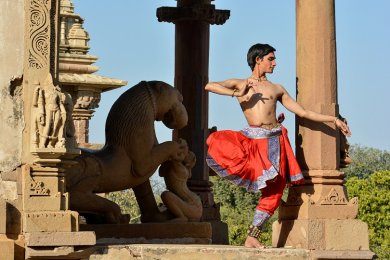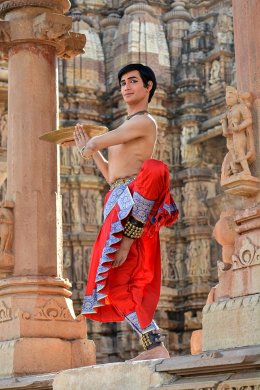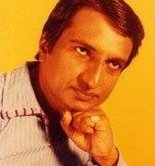
|
 |

|
 |
Avijit Das: Kuchipudi is graceful and elegant - Vijay Shanker e-mail: vijaydance@gmail.com March 9, 2021 Avijit Das was initiated into Bharatanatyam at the age of five under the guidance of Sanaka Biswas of Shanti Niketan, and obtained his Diploma in Bharatanatyam from Kalakshetra, Chennai, on a meritorious scholarship in 2011. Developing a keen interest in Kuchipudi, he had his initial training in Kuchipudi Art Academy under Guru Vempati Chinna Satyam and Manju Bharggavee. He is currently training under Jaikishore Mosalikanti. Avijit also has a Diploma in Carnatic music.  Is this the first time you are performing at the Khajuraho Festival? Yes. This has been one of the best experiences of my dancing career. I consider it an honor to perform at one of the most well-known/respected dance venues in the country for classical dances. Every aspect of the performance has been handled extremely well and with remarkable professionalism. The organization, audio, video resources, travel, accommodations were quite impeccable. Actually, I happened to see the pictures of the venue just a couple of days before my scheduled performance and I was so inspired by it, that I composed a whole piece on just the elegant architecture of the Khandariya Mahadeva temple which is included at the beginning of my performance, which was not present in my original schedule. Thanks to Arjun Bharadwaj for writing and Raghuram for composing the piece at such a remarkably short notice. I profoundly enjoyed performing at the beautiful venue and to be part of this incredible festival. What fascinates you the most about Kuchipudi? Itís the grace and elegance of the dance form. Kuchipudi is relatively of fast tempo and yet extremely aesthetic in appearance and every movement has subtle beauty. I fell in love with Kuchipudi when I first saw it being performed. Being a Bengali, is it difficult for you to understand and interpret Telugu compositions in Kuchipudi? Honestly, yes. But I work at it every day. I am learning the language. Telugu is as complex as it is beautiful and musical, with vast vocabulary and intricate literary techniques with thousands of years of literature and many unique features that no other language shares - like padyam (loosely translated to a poem) that is constructed on a number of strict grammatical rules and meters. The challenge is not to understand the lyrical meaning but the cultural and philosophical context in which a particular composition is written, and obviously for someone not born in the language and did not learn it as a mother tongue, it is tricky at times. I do it with the help of my teachers, friends, and language experts that I work with on a regular basis. Your experience with your mentors? Iíve been lucky to have great mentors in my life without who I wouldnít be here today. Not just the knowledge and technique that made me a better dancer, but their wisdom and support have always been a great gift. How do you differentiate the technique of Kuchipudi pertaining to the performance by male and female dancers? Technically, there is no difference - the basic elements of nritta, nritya, and natya are the same but what differs is the way artistes approach these based on gender. With female dancers, you tend to see more feminine attributes or subtleties being portrayed. When a male dancer performs a female piece or vice-versa, we can see the focus is on the depiction of the character itself, independent of the gender of the artiste. In general, the character that the artiste is playing determines the persona at display rather than the artiste him/her-self. How one handles each role aesthetically defines the individualís performance.  What led to your becoming a professional Kuchipudi performer? I believe the art form chooses the artiste rather than the other way round, based on my own personal experience. I came to Chennai to study Bharatanatyam and eventually ended up learning Kuchipudi during a summer break. Even in my wildest dreams, I never thought I would be a Kuchipudi artiste. Can you tell us about your academy, do you have male students also? I founded Kim Aham - school of Indian classical dance in 2011. We train students in Kuchipudi and Bharatanatyam styles. We have had about 200+ students since its inception and have about 50+ students currently, mostly through remote learning due to the pandemic. We do have a few male students but usually in limited numbers. Your favourite Kuchipudi dancers and what can you learn from them? Guru Dr. Vempati Chinna Sathyam is my biggest source of inspiration. The way he envisioned, established, and revived Kuchipudi the way it is appreciated today, is remarkable. What difficulties have you faced in order to become a male professional classical dancer? I was fortunate to have an extremely supportive family and the belief and confidence my parents have in me, without which I wouldnít be here today. They supported me every step of the way and were my source of strength to choose dance as a full-time career. Most memorable experience in life... Performing and representing Kuchipudi on many international and national venues across the world has been memorable. Participation in the Khajuraho Dance Festival has been a great memory. Performing between those pillars of Kandariya Mahadeva temple is a whole different experience altogether. Contact Avijit Das: kuchipudiavijit@gmail.com  Vijay Shankar is a Kuchipudi and Kathakali exponent, teacher, bilingual journalist, arts critic and actor. Comments * Inspirational journey of Kuchipudi dancing! Beautiful performance at the prestigious Khajuraho festival; your choreographies were brilliant! - Varsha (March 12, 2021) * What an amazing story of the dancer's entry to Kuchipudi and the talk shows his strength and confidence. Beautiful pictures and posture. (March 10, 2021) Post your comments Please provide your name and email id when you use the Anonymous / blog profiles to post a comment. All appropriate comments posted with name and email id in the blog will be featured in the site. |